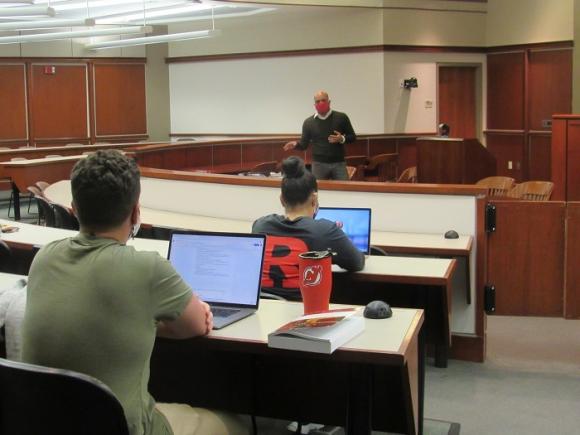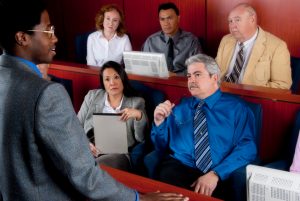Navigating the Intricacies of Test Presentations: Tips for Seamless Shipment and Compelling Debates
In the world of lawful process, the art of test presentation stands as an important factor of success. As attorneys browse the complex web of courtroom characteristics, the capacity to seamlessly provide disagreements and evidence while mesmerizing the court's interest becomes paramount. The intricacies intrinsic in trial discussions call for a delicate balance of approach, ability, and finesse. By honing strategies that guarantee a polished delivery and crafting engaging disagreements that reverberate with the target market, lawyers can significantly boost their campaigning for. In a world where persuasion rules supreme, mastering the details of trial discussions is not merely an alternative but a requirement for those seeking to dominate in the court room.

Understanding Test Goals
To efficiently browse a test, it is essential to have a clear understanding of the goals that require to be accomplished. Before entering the courtroom, lawful groups have to define their objectives and preferred outcomes. These goals work as assisting principles throughout the test, forming approaches and influencing decision-making processes.
Recognizing test purposes includes an extensive evaluation of the instance, legal precedents, and the customer's finest interests. Trial Presentations. It requires a thorough assessment of the facts, recognizing essential issues, and preparing for prospective difficulties. By establishing measurable and specific objectives, attorneys can customize their arguments and discussions to align with the wanted results
In addition, a clear grasp of test objectives makes it possible for legal groups to prioritize evidence, witnesses, and legal arguments efficiently. It permits the development of a meaningful story that resonates with the court and court, strengthening the overall case presentation.

Organizing Evidence Properly
Having a clear understanding of trial objectives lays the structure for organizing proof efficiently in lawful process. By lining up the presentation of evidence with the desired end results of the trial, lawful teams can reinforce their arguments and enhance their persuasiveness.
An additional crucial element in arranging proof properly is establishing a logical flow. Providing proof in a systematic and consecutive manner can help build a compelling narrative that supports the legal disagreements being made. Furthermore, utilizing aesthetic help such as timelines, graphs, or charts can further enhance the company of proof and aid in making clear complicated relationships or sequences of events.
Moreover, ensuring that all proof offered is pertinent and acceptable to the situation is vital. Pointless or inadmissible evidence can take away from the strength of the disagreement and possibly harm the credibility of today event. A meticulous testimonial and choice process must be undertaken to consist of only the most impactful and legitimately sound evidence in the test presentation.
Crafting Persuasive Stories
Crafting engaging narratives plays a crucial function in offering persuasive debates during lawful process. When building a story for a trial presentation, it is essential to establish a clear story that highlights key factors and attaches them in a meaningful fashion. By weaving together evidence, testament, and lawful disagreements into a convincing and natural story, legal experts can properly advocate for their clients and boost the likelihood of a beneficial outcome in the court.
Understanding Visual Aids
Effective use of aesthetic aids is crucial to pop over here boosting the impact and clearness of trial discussions. Aesthetic help, when used tactically, have the power to simplify intricate info, reinforce crucial factors, and leave a long lasting perception on the discretionary. To understand aesthetic help in test discussions, it is crucial to ensure that they are clear, concise, and relevant to the arguments being made.
When integrating visual aids, such as charts, timelines, photos, or graphs, into a trial presentation, it is vital to keep them visually appealing yet professional. The visuals ought to match the verbal arguments, offering a visual representation of the details being reviewed without frustrating the target market with unnecessary details.
Moreover, exercising with the aesthetic help in advance is crucial to guarantee a discover this info here seamless shipment during the trial. Acquainting oneself with the content, changes, and timings of each visual help can assist preserve the circulation of the discussion and stop technological problems that might occur.
Providing Impactful Closing Arguments
An engaging closing debate functions as the culmination of a test presentation, enveloping the core narrative and encouraging the court and jury towards a positive decision. To provide an impactful closing disagreement, it is essential to succinctly recap bottom lines, highlight the strengths of your instance, and deal with any type of weak points in a critical fashion. Begin by laying out the primary arguments that sustain your client's position, highlighting why the evidence offered throughout the trial sustains your narrative. It is vital to produce a feeling of cohesion and quality, directing the discretionary towards the wanted conclusion.
Moreover, incorporating sob story can further enhance your closing disagreement. By humanizing the case and linking on a personal degree with the decision-makers, you can stimulate empathy and understanding, affecting their assumption of the facts offered. Additionally, restating the lawful criteria that have to be fulfilled for a beneficial ruling can strengthen the legitimacy of your placement. Inevitably, a well-crafted closing disagreement Go Here must leave a long-term impression, compelling the judge and court to rule in your client's favor.
Verdict
Finally, mastering trial presentations involves understanding goals, arranging proof, crafting stories, utilizing visual aids, and delivering impactful closing arguments. By executing these techniques efficiently, attorneys can provide their situation perfectly and make compelling arguments in the court room. It is critical to browse the complexities of trial discussions with accuracy and skill to achieve success in lawful process.
By lining up the presentation of evidence with the desired end results of the test, legal teams can reinforce their disagreements and enhance their persuasiveness (Trial Presentations). To master aesthetic help in test presentations, it is crucial to ensure that they are clear, succinct, and appropriate to the debates being made
A compelling closing argument serves as the conclusion of a test discussion, encapsulating the core story and convincing the judge and court towards a desirable choice. Begin by detailing the primary disagreements that support your customer's setting, emphasizing why the proof provided throughout the trial sustains your narrative.In conclusion, mastering test presentations entails understanding purposes, arranging proof, crafting narratives, using visual help, and providing impactful closing arguments.
Comments on “Navigating Complex Cases: How to Develop Reliable Trial Presentations for Optimum Outcomes”